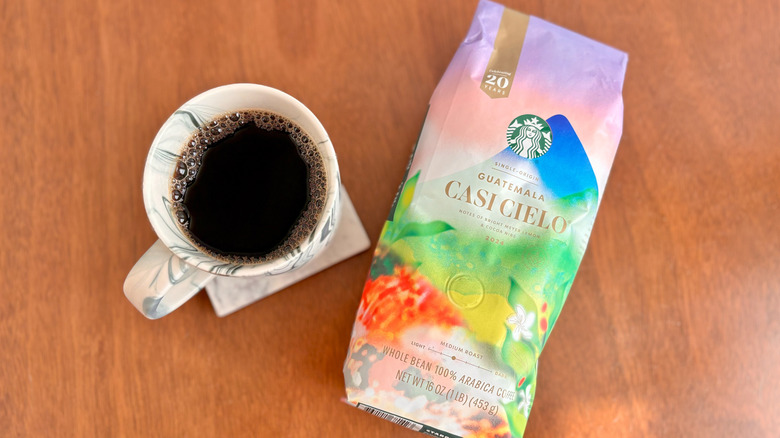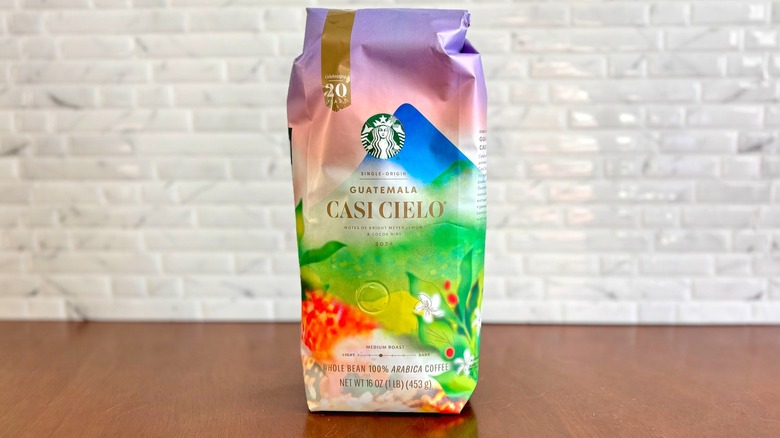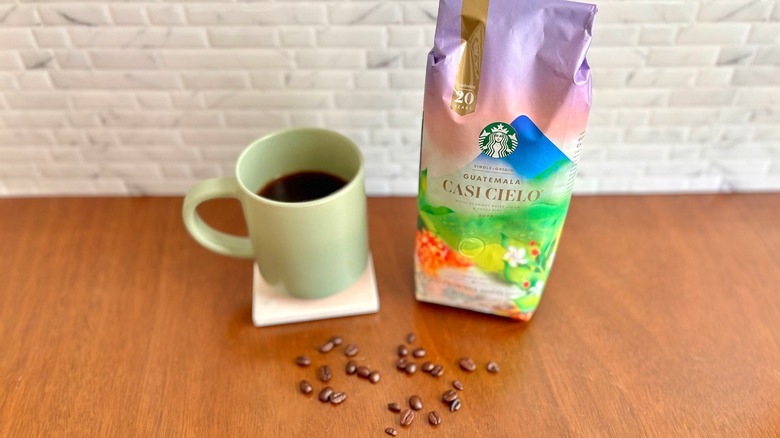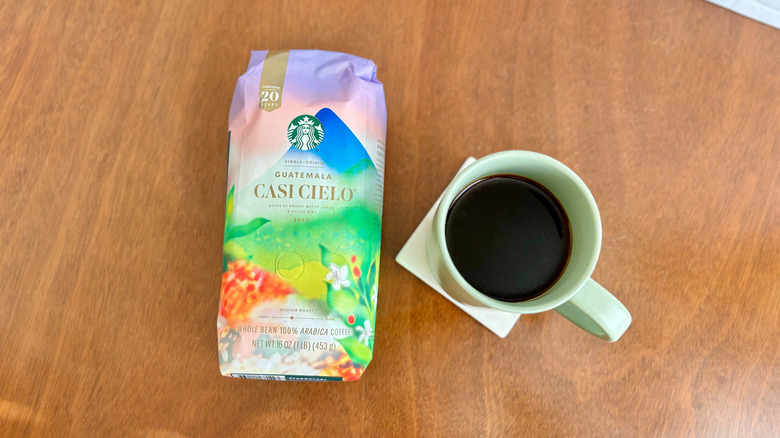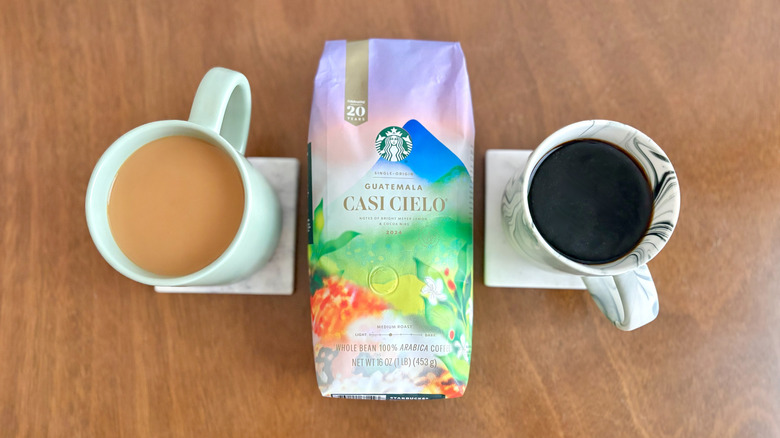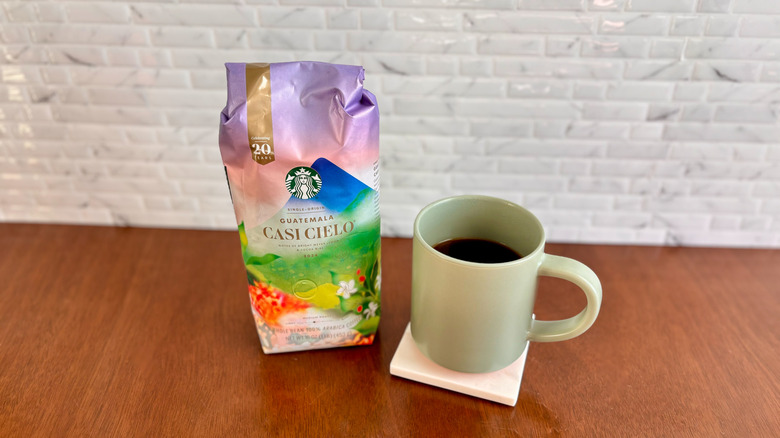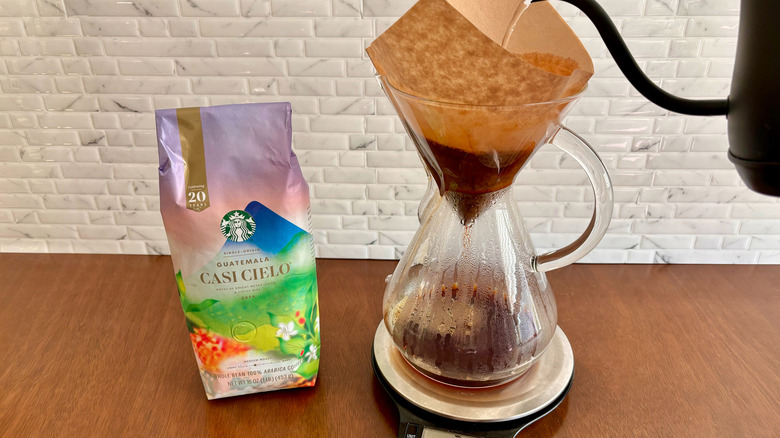Review: Starbucks' Guatemala Casi Cielo Whole Bean Coffee Is A Nuanced Brew Worth Trying
While many people associate Starbucks with lattes, cold foam cold brew, and Frappuccinos, the ever-popular coffee chain also keeps things classic with black coffee. If you were to order a hot, black coffee in-store, there's a good chance you'll face a trio of choices: Pike Place, a medium roast blend, Veranda blend, which is a light or blonde roast coffee, and caffe Verona, a dark roast. Avid Starbucks fans likely know that the chain's coffee scope stretches far beyond these three general selections, and if you were to buy a bag of whole bean coffee at a Starbucks location, you're going to come across a larger variety of coffee, including specialty blends.
Enter Starbucks' Guatemala Casi Cielo, a medium roast, single-origin blend that first came on the scene in 2004 and has made its annual return, with 2024 marking its 20th anniversary. Boasting "notes of bright Meyer lemon and cocoa nibs," according to its packaging, Casi Cielo translates from Spanish to "almost heaven," but does the coffee live up to its name? I sampled Casi Cielo to determine whether or not it's worth it to flock to your nearest Starbucks to grab a bag. Aside from flavor, which is the most important factor, I'm also considering accessibility, price, and overall value.
Some recommendations are based on firsthand impressions of promotional materials and products provided by the manufacturer.
What is Starbucks' Guatemala Casi Cielo coffee?
Before diving into the nitty gritty of brewing and sipping on Guatemala Casi Cielo, it's important to establish what this blend is, exactly, and how it differs from others out there. A single-origin blend from Guatemala, and more specifically, coffee that is grown on the tall mountains of Antigua Valley (also inspiration for the blend's heavenly name), Casi Cielo is a medium roast coffee. Now, nearly all coffee is going to have a somewhat similar flavor profile, but different roasts will bring about different flavor notes. A lighter roast will be more acidic and perhaps even fruity, whereas a dark roast will be bolder and more robust.
So, naturally, a medium roast like Casi Cielo would fall somewhere in between these two flavor profiles, or at least it should. As I've already noted, the flavor notes listed on the front of the bag include Meyer lemon and cocoa nibs, which sort of play on both the acidic notes that you might expect from something lighter and the richer, chocolatey notes that you might find in something darker.
A bag of Casi Cielo comes in whole bean form, which means that you'll need to have a grinder to brew at home. You could have a barista grind the beans in-store, but it's best to store whole bean coffee as-is and grind right before brewing for the freshest cup possible.
Where can I find a bag, and how much does it cost?
Seeing as Guatemala Casi Cielo is a Starbucks coffee blend, unsurprisingly, you'll be able to find bags of these beans at Starbucks locations. It's important to note that this particular blend, unlike certain Starbucks blends that are available year-round, is a seasonal one, which means it won't be available for long. It does return every year, but if you're interested in trying Casi Cielo sooner rather than later, you should head to your nearest Starbucks location to see if it's in stock. Also, those who don't want to commit to a whole bag may be able to try a single cup of brewed Casi Cielo at a Starbucks location with a Clover Vertica, a specialty machine that can brew single cups of coffee in a jiffy.
As for price, a 1-pound bag of Casi Cielo was $15.95 at my nearest Starbucks location in Chicago, but this price could vary depending on where you're located. A grande cup of Casi Cielo at the same location is priced at $2.95.
Taste test
The first thing I noticed about Guatemala Casi Cielo, upon first sip, was a certain brightness that I typically only notice when drinking lighter roasts. Interestingly, the brightness sort of mellowed out a bit as the coffee settled on my palate, and the lingering taste was one that was quite robust, something more typical with dark roasts. It makes sense that Casi Cielo would boast such flavors, as it is a medium roast, but I particularly enjoyed the complexity of flavor that even one sip had to offer.
After a few sips, I started to pick up on some light floral notes, though the characteristic slight bitterness of black coffee did start to become more and more apparent. For what it's worth, this blend isn't too bitter despite being heavier on the acidic side, and even those who aren't typically fans of black coffee might appreciate the nuance of flavor that Casi Cielo has to offer. Was I picking up on specific citrus notes, like Meyer lemon? No, not really, but there was a certain citrusy element to the coffee, and the aftertaste of cocoa nibs came through strongly. As someone who prefers dark roast coffee, I was pleasantly surprised to discover that this medium roast blend had a certain richness and boldness to it. Yet, for those who don't like dark roasts, fear not — this is a medium roast through and through, and there's plenty of brightness to contrast against any robustness that Casi Cielo has.
Is Casi Cielo better black or with cream?
Coffee purists might argue that any cup of brewed coffee, specialty blend or not, should be enjoyed black. The only issue with that argument is that not everyone likes black coffee, so even if you want to experience Guatemala Casi Cielo and enjoy all of those nuanced flavor notes, there's a good chance you might want to add a splash of cream while you're at it. I've accounted for those who enjoy their cup of joe with cream or milk by sampling Casi Cielo both black and with half and half to determine which is the better cup.
As someone who does typically drink their coffee black, I did find myself enjoying the cup with half and half more than expected. Any bitter edge that this coffee might have is immediately tempered by even just a splash of cream, so if bitterness in coffee is something you really don't like, then a touch of cream and perhaps a little bit of sugar would be the way to go. That said, the plain black cup definitely had more dimension and complexity to it, so if you aren't opposed to black coffee, it's at least worth trying Casi Cielo cream-free. Though the half and half certainly didn't make the coffee worse, it muted the flavor notes a little bit, making it taste more like any old cup of coffee than a specialty blend.
Starbucks' Guatemala Casi Cielo whole bean coffee — is it worth seeking out a bag?
I've covered what Guatemala Casi Cielo is, established where to find it, and have tasted it plain and with cream — the only question that remains is whether or not buying a bag is worth it. Ultimately, the answer to that question is a yes, as this is a solid blend and one that definitely shines amid Starbucks' more general, run-of-the-mill blends. If you're a coffee aficionado and particularly love drinking coffee for the sake of pinpointing flavor notes, then this is a good blend for doing so, as it does offer a decent amount of complexity. Even if you're someone who goes to Starbucks frequently but only sometimes buys bags of whole beans, you'd be doing yourself a huge favor by opting for Casi Cielo over your typical Pike Place.
Now, I'm not exactly saying that this blend is worth dropping everything and running to Starbucks to grab, but it is worth checking out if you have the chance. Casi Cielo isn't available year-round, and though it does return eventually, coffee lovers might be disappointed if they miss out on the Guatemalan blend's 2024 run. The beans are a bit pricy at about $16 per bag, but considering how many brews you'll get out of a single bag and the sheer quality of the product, the price is pretty reasonable.
Methodology
There are seemingly endless ways to brew a cup of coffee, and when it came to sampling Guatemala Casi Cielo, I opted for the pour-over method. This method is great for a handful of reasons, but to just name a few, measurements (for both coffee and water) are more accurate than when you're brewing a whole pot, you have more control over the temperature of your water, and the flavor of your brewed cup will be about as balanced and pronounced as it gets. Plus, when making a pour-over, you can measure and grind the beans right before brewing, so your cup of coffee will be impeccably fresh.
All of these reasons led me to using the pour-over method to sample Casi Cielo. Since this is a specialty blend, I wanted to be able to pick up on any and all flavor notes. I followed the measurement instructions as they were listed on the bag, which called for 2 tablespoons of coffee per 6 ounces of water. So, for a 12-ounce cup, I ground 4 tablespoons of Casi Cielo, brewed it, and enjoyed immediately. I believe this method gave me the most accurate impression of Casi Cielo, though it is worth noting that if you try Casi Cielo yourself, the flavor may vary slightly depending on how fresh your beans are and the method you use to brew the coffee.
